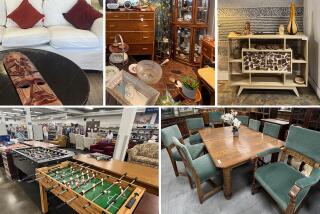Burlap is the new velvet
Coffee tables made from barrels. Lamps crafted from brooms. Chairs swathed in burlap and sackcloth. Look at the some of the newest furniture on the market, and the recession appears to have really hit home. But irony alert: This new brand of shabby chic doesn’t come cheap.
At the Dan Marty showroom in the Pacific Design Center, the heart of West Hollywood’s design scene and the place where top decorators shop for their wealthy clients, light fixtures made from old French apple baskets carry $1,600 price tags and canopy chairs upholstered in burlap sell for $3,600 a pair.
“Some of these pillows cost $600 each,” Marty said, pointing to shams made from grain bags. Customers tease him about the high prices, but the pillows are selling -- about two dozen a month. Kathy Hilton, Paris’ mom, just picked up eight of them.
At Environment Furniture, an eco-chic retailer that counts actor-environmentalist Leonardo DiCaprio as one of its customers, giant floor cushions are made of truck tarps and $3,000 sectional sofas are upholstered in material from old pup tents and other military textiles.
Such humble looks would have probably drawn disdain from style-conscious consumers addicted to Hollywood glamour and glitz a few years ago, but times have changed and so have many high-end home fashions. Some of today’s expensive decor seems more “Beverly Hillbillies” than “Beverly Hills 90210.”
Like a dowager in a Chanel jacket with frayed cuffs, the look suggests modesty -- people of means who wish to express their taste without flaunting their relative immunity to the recession.
Brooke Hodge, former curator of architecture and design at the Museum of Contemporary Art in Los Angeles, has christened it “dumpster diver deluxe.”
Arbiters of style such as Jonathan Adler, a Melrose Avenue boutique owner and judge on the Bravo show “Top Design,” see the trend as the convergence of several looks: an organic, modern direction evidenced in tree-stump end tables and other designs that recall the back-to-nature hippie era; the urban loft aesthetic, which embraces castoff industrial furnishings and found objects; and a growing green consciousness, with an emphasis on recycled materials.
“People used to say that ‘less is more’ meant ‘more expensive,’ ” Adler said. “Now you can say humble is the new grandeur.”
Recession chic exudes the “romance and pioneer spirit of homesteaders,” said Newell Turner, style director at the 113-year-old House Beautiful, the oldest continuously published shelter magazine in the U.S. “If you work at a computer all day, you have a heightened need for a connection to nature and things that are earthy and homespun.”
Regardless of its origins, dumpster diver deluxe is resonating among affluent shoppers who simply want to dial down ostentation and not appear out of step with the times.
“I’ve seen high-end chairs stripped of gilt to the natural wood and upholstered in very plain canvas,” Hodge said. “That’s a more refined, less trendy way to show restraint.”
The trend has prompted some cynicism in the design community.
Matilda McQuaid, deputy curatorial director of the Smithsonian’s Cooper-Hewitt, National Design Museum in New York, said the phenomenon was hard to define as restraint when the merchandise was still expensive.
“There is even a theatrical aspect to it as if the wealthy are trying to play the role of an ‘impoverished man,’ but in a very safe way,” she said.
Such designs could be a short-lived fad -- “like patched jeans,” McQuaid said.
But part-time Los Angeles resident Bo Banks disagrees. The television producer bought a $3,500 Dan Marty chaise covered in burlap for her Chicago apartment.
“I don’t think it’s a fad,” she said. “When you see something that looks like a traditional antique covered in a plain and natural fabric, it looks fresh and beautiful -- casual but still a little fancy.”
At Los Angeles-based Cisco Brothers, whose furniture is sold at 350 retailers nationwide including the company’s flagship stores in Pasadena and on La Brea Avenue in L.A., owner Francisco Pinedo is marketing ottomans upholstered with recycled leather patchwork.
What’s more, about 20% of Pinedo’s line is one-of-a-kind furniture made from reclaimed wood. This year, he said, the company is on track to sell 100 tables made from wine barrels and reclaimed stone tops. Prices start at $1,240.
Sue Cowie, owner of the store Colcha on Abbot Kinney Boulevard in Venice, said her $1,600 apiece club chairs, upholstered in recycled grain sacks, are not aimed at the recently unemployed but rather architects and artists drawn to the humble look.
“The fabric is the trend,” she said, echoing some designers who speculate that as family budgets tighten, purchasing decisions once made largely by women are increasingly being made in part by husbands and partners who may favor a less frilly, more masculine look.
But Davide Berruto, chief executive of Environment Furniture, said the explanation was simpler.
“Bling is out,” said Berruto, whose company started offering furniture upholstered in tarps and military fabrics a year ago. Those pieces outsell traditional cottons and linens, he said, and they account for nearly a third of all sales. “There are people who still need $200-a-yard velvet on their sofas,” he added, “but people are increasingly questioning the value of conspicuous consumption and disposable goods.”
In addition, he said, “There’s hardly anything that kids and pets can do to trash a sofa covered in tent fabric.”
Many consumers probably will remain unconvinced -- and unamused. Some furniture already takes some not-so-cheap shots at the facade of modesty.
The furniture-as-art gallery Moss in L.A. has a piece by Italian designer Andrea Salvetti, who took a plain, slatted wooden fruit crate and audaciously cast it in beautiful polished aluminum. Price: $2,695.
At the recent Salone Internazionale del Mobile, the world’s premiere design show in Italy, Tord Boontje showed prototypes of the Crate sofa, whose boxy frame looked like packing crates but was covered in unabashedly pretty floral cushions.
And proclaiming that nothing is more beautiful than cold hard cash, Marina del Rey designer Stuart Karten has built a prototype for a lighting line called Kurrency.
The Washington model consists of 250 one-dollar bills meticulously curled and suspended from rings, forming a “shade” with the soft green glow of legal tender. From inside the lamp, a projector casts words such as “Greed,” “Materialism,” “Capitalism” and “Democracy” onto your dinner table. It’s yours, for a mere $5,500.
--


